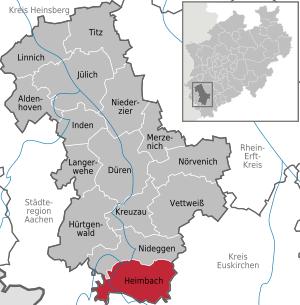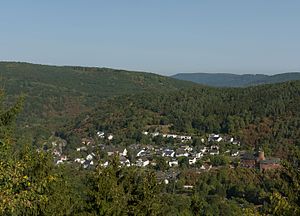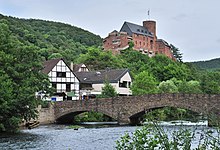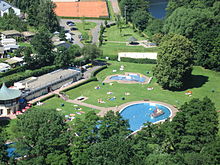Heimbach (Eifel)
| coat of arms | Germany map | |
|---|---|---|

|
Coordinates: 50 ° 38 ' N , 6 ° 29' E |
|
| Basic data | ||
| State : | North Rhine-Westphalia | |
| Administrative region : | Cologne | |
| Circle : | Düren | |
| Height : | 227 m above sea level NHN | |
| Area : | 64.96 km 2 | |
| Residents: | 4328 (Dec. 31, 2019) | |
| Population density : | 67 inhabitants per km 2 | |
| Postal code : | 52396 | |
| Primaries : | 02446, 02425 | |
| License plate : | DN, JÜL, MON, SLE | |
| Community key : | 05 3 58 012 | |
| City structure: | 7 districts | |
City administration address : |
Hengebachstrasse 14 52396 Heimbach |
|
| Website : | ||
| Mayor : | Peter Cremer (independent) | |
| Location of the town of Heimbach in the Düren district | ||
Heimbach is a town in the Rureifel . It belongs to the district of Düren and is the smallest town and the second smallest municipality in North Rhine-Westphalia in terms of population . Its town center had a total of 1083 inhabitants on July 31, 2017 and is a popular destination in the Eifel National Park .
geography
Geographical location
Heimbach is located in the Rur valley below the Schwammenauel dam on the Heimbach reservoir . The Sonnenberg is located in the city center . The city in the Eifel is developed for tourism and is often visited by day trippers from the nearby cities of Aachen , Cologne and Bonn as well as Belgium and the Netherlands . The city has been a state-approved climatic health resort since September 13, 1974 .
Neighboring communities
| District of Düren | City region Aachen | District of Euskirchen |
|---|---|---|
City structure
Heimbach consists of the districts
There are also several smaller settlements, including the Fischbachtal , Walbig , Schwammenauel and the Buschfelder Hof .
history
Heimbach was first mentioned in a document in 673 in deeds of donation from the Frankish King Theodorich I , Vlatten and Hergarten were first mentioned in the 9th century. In the 10th century, the royal court of Vlatten was relocated to Hengebach Castle .
Lothar II acquired the village of Hergarten from the Prüm monastery in 864 . In 1288 Heimbach became the center of a Jülich office and Hengebach Castle became the seat of a Jülich burgrave . Around 1300 Heimbach was given a town-like character after the settlement was fortified.
Since 1602 in Heimbach are fairs held, the market for hard Visitation held on the occasion of the pilgrimage oktav still held today. In 1614 Heimbach moved to Wolfgang Wilhelm von Pfalz-Neuburg with the end of the Jülich-Klevischen succession dispute , from 1815 it belonged to Prussia . In 1903 the city was connected to the railway network and in 1904 the Urfttalsperre was completed. Due to the new local recreation area, tourism in the place increased sharply. On April 8, 1959, Heimbach was reassigned its city rights due to its historical past and in recognition of Heimbach as a center of tourism.
Heimbacher chair
From the 17th century to the present day, Heimbacher chairs are made in the village. These little chairs were previously turned from beech wood in the winter months. There was even a factory that operated on the site of today's building yard. Today the small chairs are only made in small numbers as souvenirs. In the past, wooden bowls and wooden spoons were also made and sold as far as Maastricht .
religion

Heimbach is a well-known place of pilgrimage. Since 1804, believers have made a pilgrimage to the Sorrowful Mother of Heimbach , a Pietà in the parish church of Heimbach . In the course of secularization , the Pietà from the 15th century was transferred from the Trappist monastery in Mariawald to the Heimbach parish church of St. Clemens on June 22nd, 1804 together with an Antwerp reredos from the 16th century . Today the Pietà and reredos can be seen in the Heimbach Salvator Church, consecrated on May 24, 1981. The Catholic parishes in Heimbach belong to the diocese of Aachen . The Christians of the Evangelical Church in the Rhineland in Heimbach belong to the Evangelical Trinity Parish in the Schleidener Tal .
Reorganization
On July 1, 1968 Hausen was incorporated. Hergarten and Vlatten followed on July 1, 1969. The town of Heimbach came from the Schleiden district to the Düren district on January 1, 1972 and was merged with the town of Nideggen. On August 4, 1972, the constitutional court for the state of North Rhine-Westphalia ruled that Heimbach should become an independent municipality again.
politics
City council
The result of the local elections on May 25, 2014 can be seen in the adjacent graphics.
Coat of arms, flag and banner
- Blazon : "In black, a seven-pinned, black-jointed silver tower with a projecting base and a pointed arched gate with half-drawn portcullis, behind the battlements a red-tiled pointed roof with a silver tower ball and a rear battlement covered with red tiles, each end in a red weir bay window with a machicolation. the base covered with a leaning label, in it a red-armored and red-tongued black lion in gold. "
- Declaration of coat of arms: The tower stands for the early (1300) fortification of the place, the leaning shield shows the Jülich lion, which indicates that it belongs to the Duchy of Jülich. The coat of arms of Heimbach is similar to the coat of arms of Hof an der Saale : silver pinnacle tower or pinnacle towers with leaning lion shield (Jülich or Wittelsbach lion). The reason is that in Schmidt , a former village of Hengebach Castle, until 1749 a branch of the knightly family von Schmidt auf Altenstadt, now living in the Netherlands, was resident, whose ancestral home was the manor Schloss Gattendorf, built by them around 1700, in Kirchgattendorf near Hof in Upper Franconia lies.
Description of flag and banner: “The flag of the city of Heimbach shows the colors white-black-white in longitudinal stripes in a ratio of 1: 2: 1 with the city coat of arms in the middle. It can also be used as a banner. "
Culture and sights
free time activities
In the 1880s, the Belgian Queen Marie Henriette repeatedly visited the Eifel. During one of her trips in 1881, she paid a visit to the Mariawald monastery, accompanied by the Heimbach pastor Karl Kalff. On this occasion she also reached the Griesberg above Heimbach, from which one has a beautiful view of Heimbach and the Rur valley. Queen Marie Henriette was so enthusiastic about this view that she had a lookout and picnic area with stone benches built here that same year. In 1904 the place was repaired by the Eifelverein. In 1936, the Rhineland Regional Council was rebuilt, and in 1963 some parking areas were created. In 1978 the picnic area was redesigned by the Belgian administration of Burg Vogelsang and the city of Heimbach.
The Heimbach National Park Gate with the exhibition “Secrets in the beech forest” and important information about the Eifel National Park is located in Heimbach train station. In a ceremony on September 18, 2011, the station was recognized as the 2011 NRW hiking station. From there, many hiking trails lead to the near and far. The Eifel can also be explored from here by bike or mountain bike. The long-distance cycle paths lead through the village:
- Eifel-Höhen-Route , which leads as a circuit around the Eifel National Park.
- RurUfer cycle path , which connects the highest point of the High Fens with the confluence of the Rur and the Meuse .
- D Route 4: Mittelland Route : From Aachen via Bonn and Siegen , Erfurt , Jena and Chemnitz to Zittau .
- D-Route 7: Pilgrim route : From Aachen via Cologne , Düsseldorf , Duisburg , Münster , Osnabrück , Bremen and Hamburg to Flensburg .
- The 524 km long moated castle route leads through the Hausen district . It connects more than 130 castles on the edge of the Eifel and in the Cologne Bay .
There is also a mini golf course in Heimbach and a spacious outdoor pool with a beach volleyball court.
museum
The RWE industrial museum with everyday electrical devices is located in the Heimbach power station . The DKB Time Travel Museum was opened in the train station in October 2009.
music
The concerts “Tensions” with the artistic director and pianist Lars Vogt , which have been taking place in the Kraftwerk since 1998, are known far beyond the country's borders .
Buildings
The former Mariawald Abbey , the only male Trappist monastery in Germany, is located in Heimbach . The monastery was closed in 2018. The Heimbach war cemetery is located southwest of the abbey . It was created in the 1950s on the initiative of the Volksbund Deutsche Kriegsgräberfürsorge and was inaugurated on September 20, 1953. There are a total of 414 fallen from the Second World War .
Heimbach, with its own small Protestant church, belongs to the Protestant parish of Gemünd.
The Heimbach power plant is located below the Urft dam , an Art Nouveau hydropower plant built in 1904 to generate electrical energy .
The town of Heimbach is dominated by Hengebach Castle, which was first mentioned in 1106. After the first groundbreaking on November 20, 2008 for the renovation, it became the seat of the "International Art Academy Heimbach".
traffic
- A trackless train that Rursee train, traveling in the summer months from the station Heimbach on the Nouveau power plant Heimbach from the dock for Rursee boat trip in Schwammenauel (Heimbach Hare Field).
- The Rursee shipping offers boat connections from Heimbach-Schwammenauel to the other Rursee neighboring towns of Nideggen-Schmidt ( Eschauel ), Woffelsbach and Rurberg , as well as to the Kermeterufer in the Eifel National Park .
- In the area of Vlatten, Hergarten and Düttling, the B 265 crosses the city.
- From 1922 to 1926 the Eifelrennen ran through the town.
Rail transport


- Heimbach is the terminus of the Linnich – Düren – Heimbach railway into the Eifel. The station is of touristic importance as a gateway to the national park and as an information center for hikers and tourists.
| line | Line course | Tact |
|---|---|---|
| RB 21 |
Rur Valley Railway : Düren - Annakirmesplatz - Kuhbrücke - Lendersdorf - Renkerstr / Hospital - Tuchmühle - Kreuzau - Kreuzau, Eifelstraße - Üdingen - Untermaubach-Schlagstein - Obermaubach - Zerkall - Nideggen-Brück - Evenings - Blens - Hausen - Heimbach Status: timetable change December 2015 |
30/60 ( SVZ ) min (Düren - Untermaubach) 60 min (Untermaubach - Heimbach) |
Bus transport
- Heimbach is connected to the public transport network of the Aachen transport association with line 231 .
- "Mäxchen" is the name of a bus on the Düren district railway , which runs over the Eifel heights on weekends and public holidays between May and October / November, sometimes with a guide.
- Bürgerbus (BBH) is the name of the city bus and runs in the Heimbach area.
| line | course |
|---|---|
| 231 | Düren Bf / ZOB - StadtCenter - Kaiserplatz - Josefskirche - Stockheim - Froitzheim - Ginnick - Embken - ( Muldenau ←) Wollersheim - Vlatten - Hergarten - Heimbach Bf - ( Hasenfeld - Schwammenauel - Kermeter - Urfttalsperre / Hastenbach - / Mariawald Abbey -) Wolfgarten - Gemünd - Nierfeld - Olef - Schleiden |
| BBH |
Citizen bus Heimbach: ( Blens ) - Hasenfeld - Heimbach train station - Hilbach - Vlatten / ( Hergarten - Düttling ) |
| Mäxchen | Heimbach Bf → ( Mariawald Abbey → Kermeter → / Hasenfeld →) Schwammenauel (dam) → ( Schmidt Wildpark → Schwammenauel (dam) →) Hasenfeld → Heimbach Bf |
Others
In a study by the University of Trier in 2008, in which 158 climatic health resorts in six federal states were assessed, Heimbach took first place.
Personalities
sons and daughters of the town
- Johann Peter Schroeder (1794–1876), politician
- Marion Winkel-Wergen (* 1957), artist and ceramist
Personalities who have worked in this city
- Balderich von Drenthe (~ 965–1021), Count in Düffelgau and Count of Drenthe
- Georg Frentzen (1854–1923), architect and university professor; built the Heimbach power plant (hydropower plant of the Urft dam) in Heimbach-Hasenfeld in 1904
- Franz Binz (1896–1965), member of the Reichstag for the NSDAP, lived in Heimbach
- Stephan Meyer (director) (* 1947), director, lives a. a. in Heimbach
- Luise Kött-Gärtner (* 1953), plastic artist; designed a labyrinth in Heimbach
- Johannes Bündgens (* 1956), pastor in Heimbach and auxiliary bishop in the diocese of Aachen
literature
- Josef Daheim: Heimbach and its districts - the past in words and pictures . Horb am Neckar 1990.
- Fassbender: Heimbach Castle and the Counts and Lords of Hengebach . Bochum 1868, urn : nbn: de: hbz: 061: 1-64942 .
- Christian Quix : The Counts of Hengebach. The castles and towns of Heimbach and Niedeggen . The former monasteries Marienwald and Bürvenich and the Collegiatstift later Minoriten monastery before Niedeggen; represented historically. Ed .: Hensen. Aachen 1839 ( google.de [accessed on August 8, 2017]).
- Norbert Saupp: Heimbach - Blens, Düttling, Hausen, Hasenfeld, Hergarten, Vlatten . Heimbach 1993.
- Hans Peter Schiffer: Churches, chapels and crosses in the Heimbach urban area . History - construction - equipment. Verlag Ralf Liebe, Weilerswist 2008.
- Heimbach . In: The beautiful Eifel . History - natural landscape - the climatic health resort / guide through the city, hiking suggestions. Düren 1987.
Web links
- Rureifel tourism in the Heimbach National Park gate
- The Eifel water information center
- “Tensions” in the Heimbach power plant
- Monuments in the city of Heimbach
Individual evidence
- ↑ Population of the municipalities of North Rhine-Westphalia on December 31, 2019 - update of the population based on the census of May 9, 2011. State Office for Information and Technology North Rhine-Westphalia (IT.NRW), accessed on June 17, 2020 . ( Help on this )
- ↑ Gudrun Klinkhammer: Heimbacher Stühlchen: Created in the shadow of the castle. In: Aachener Zeitung. January 9, 2017. Retrieved August 8, 2017 .
- ^ A b Martin Bünermann: The communities of the first restructuring program in North Rhine-Westphalia . Deutscher Gemeindeverlag, Cologne 1970, p. 65 and 100 .
- ^ Federal Statistical Office (ed.): Historical municipality directory for the Federal Republic of Germany. Name, border and key number changes in municipalities, counties and administrative districts from May 27, 1970 to December 31, 1982 . W. Kohlhammer, Stuttgart / Mainz 1983, ISBN 3-17-003263-1 , p. 306 f .
- ↑ Judgment of August 4, 1972 - VerfGH 13/71 - GV. NRW. 1972 p. 258 = OVGE 28, 304
- ^ City of Heimbach. Overall result. May 25, 2014, accessed October 20, 2014 .
- ↑ Main statute of the city of Heimbach, § 2 paragraph 1 and 2. (PDF; 478 kB) Retrieved on December 20, 2012 .
- ↑ Heimbach is NRW hiking station 2011. Accessed on April 4, 2013 .
- ^ Hengebach Castle. Burgenwelt, accessed on April 10, 2016 .
- ↑ Rursee shipping. Welcome on board. Rursee-Schifffahrt KG, accessed on April 10, 2016 .
- ↑ https://www.dkb-dn.de/fileadmin/downloads/PDF/Maexchen_2017_1.pdf
- ↑ Study by the ETI at the University of Trier, 2008 ( Memento of the original from December 6, 2008 in the Internet Archive ) Info: The archive link was inserted automatically and has not yet been checked. Please check the original and archive link according to the instructions and then remove this notice. (PDF; 432 kB)
- ^ Horst Wallraff: Franz Binz (1896–1965), district leader of the NSDAP. In: Portal Rhenish History. Landschaftsverband Rheinland, accessed on August 8, 2017 .











